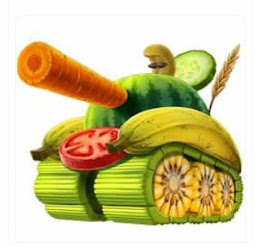 |
| Garden cress leaves |
Cress (Lepidium sativum), sometimes referred to as garden cress to distinguish it from similar plants also referred to as cress (from old Germanic cresso which means sharp, spicy), is a rather fast-growing, edible herb.
Garden cress is genetically related to watercress and mustard, sharing their peppery, tangy flavor and aroma. In some regions, garden cress is known as mustard and cress, garden pepper cress, pepperwort peppergrass, or poor man's pepper.
This annual plant can reach a height of 60 cm (~24 inches), with many branches on the upper part. The white to pinkish flowers are only 2 mm (1/12 of an inch) across, clustered in branched racemes.
Garden cress, raw
Nutritional value per 100 g (3.5 oz)
Energy 134 kJ (32 kcal)
Carbohydrates 5.5 g
Sugars 4.4 g
Dietary fiber 1.1 g
Protein 2.6 g
Vitamins
Vitamin A equiv. (43%) 346 μg
beta-carotene (38%) 4150 μg
lutein zeaxa 12500 μg
Thiamine (B1) (7%) 0.08 mg
Riboflavin (B2) (22%) 0.26 mg Niacin (B3) (7%) 1 mg
Pantothenic acid (B5) ( 5%) 0.247 mg
Vitamin B6 (19%) 0.247 mg
Folate (B9) (20%) 80 μg
Vitamin C (83%) 69 mg
Vitamin E (5%) 0.7 mg
Vitamin K (516%) 541.9 μg
Minerals
Calcium (8%) 81 mg
Iron (10%) 1.3 mg
Magnesium (11%) 38 mg
Manganese (26%) 0.553 mg
Phosphorus (11%) 76 mg
Potassium (13%) 606 mg
Units
μg = micrograms • mg = milligrams
IU = International units
Percentages are roughly approximated using US recommendations for adults.
Source: USDA Nutrient Database
Uses of Garden Cress
Garden cress is added to soups, sandwiches and salads for its tangy flavor. It is also eaten as sprouts, and the fresh or dried seed pods can be used as a peppery seasoning (haloon).In England, cut cress shoots are commonly used in sandwiches with boiled eggs, mayonnaise and salt.
Garden cress, known as chandrashoor, and the seeds, known as halloon in India, are commonly used in the system of Ayurveda to prevent postnatal complications.
Garden cress seeds, since ancient times, have been used in local traditional medicine of India. Seeds have been shown to reduce the symptoms of asthma and improve lung function in asthmatics. The seeds have been reported as possessing a hypoglycemic property in rats and the seed mucilage is used as a substitute for gum arabic and tragacanth.
Cress may be given to budgerigars. Some use it in the belief that it can cure asthma, bronchitis and bleeding piles.
Some use Lepidium sativum seeds for indigestion and constipation.
House fumigation
Garden cress seeds are burnt in the room to release fumes. It kill all types of insects and mosquitoes. It is wonderful natural solution for insects. It is harmless for human beings but kills all germs in the house. Give your home this treatment off and on to make germ free room air.
Garden cress leaves tea for tummy pain or abdomen pain
It's tea can treat any type of abdominal pain or tummy pain. It is traditional in Arabs for to this purpose. They use this tea for any abdominal pain. The pain goes away in minutes. Add homeyto the tea to sweeten it. Honey is a wonderful herb on this Earth. This tea also reduces one's weight.




.jpeg)
0 Comments